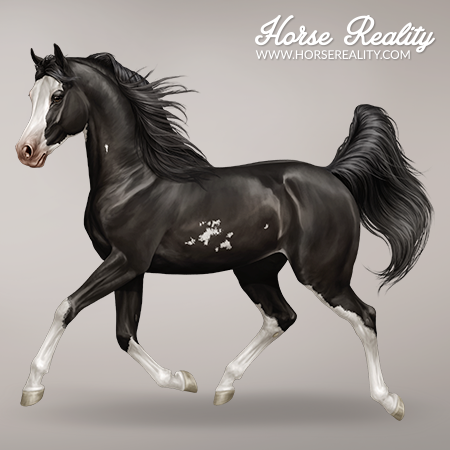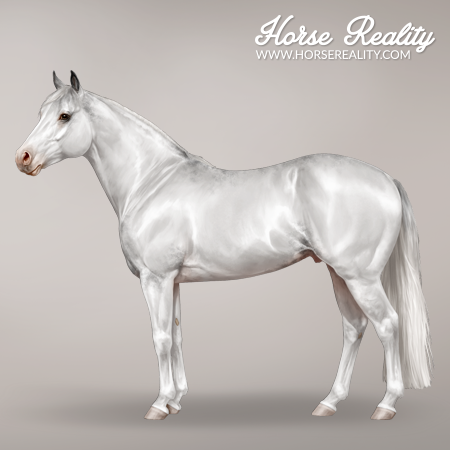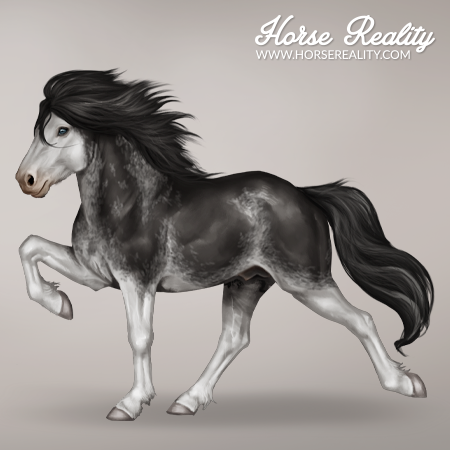White spotting, in the past also known as dominant white, is a general name given to a large group of related white patterns.
¶ Phenotype
Currently, 39 different variations of white spotting patterns have been discovered in real life. There is a large variability in the type of pattern and amount of white caused by each of the different variations. The expression may vary from leg and face markings with or without white patches on the belly, to even a nearly “white” phenotype. In these nearly “white” horses, the topline of the horse may retain some pigment. The white markings and patches often have irregular, jagged edges. White ticking or “roaning” on the body is also quite common.
White spotting affects any base colour, but the presence of dilutions or grey may make the white pattern harder to see. Very expressive white spotting patterns may make it difficult to recognise the underlying colour of the horse without genetic testing.
| White Spotting - Various breeds | |

|

|

|

|
The word “sabino” is often used for white spotting-like patterns that have not yet been identified. Examples of this are patterns seen in breeds such as Akhal-Tekes, Shire Horses or Welsh Ponies. These unidentified patterns are commonly called “sabino” or "hidden/untestable sabino". In Horse Reality, they are implemented as hidden sabino.
¶ Genotype
The white spotting alleles are mutations found at the KIT locus. Currently (May 8th, 2025), 39 different white spotting variations (W1-W39) have been discovered and are available for testing in real life. Not all of the currently known mutations have been implemented in the game yet, as a lot of them have only been discovered quite recently. At the moment, only W3, W10, W19, W20 and W21 are in-game. These can be tested at the Laboratory.
Sabino1 was the first white spotting variation to be discovered. Researchers named the responsible allele "sabino1" with the expectation that later alleles would be named "sabino2", "sabino3", and so on. They were matching the terminology already used by horse breeders, and they also didn’t want to scare or confuse people with connotations based on the OLW gene in horses. However, as more and more alleles were being discovered, they decided to change their naming convention to “dominant white”, with W1, W2, and so on instead. This was based on the terminology used in mice, where a similar dominant white locus is present. These patterns in mice are homozygous embryonic lethal, and the same was initially assumed for horses. Later on, it was discovered that certain W-alleles are actually viable in the homozygous state. Following this, the name of these alleles was once again changed to “white spotting”.
The dominance of the white spotting alleles thus depends on the variation. Many are still suspected to be dominant and non-viable when homozygous (W/W). However, some variations appear to be incomplete dominant in real life, which means that horses that are homozygous will show larger amounts of white than horses that are heterozygous. However, in-game, ALL homozygous white spotting combinations are currently NOT viable (see below).
The list of white spotting alleles keeps expanding quickly, as research uncovers more and more new variations. It is very likely that there are still many more out there that have not been identified yet! As mentioned earlier, unidentified white spotting-like patterns are implemented in the game as hidden sabino.
¶ Breeding
At the moment, only W20 is viable when homozygous (W20/W20). Breeding two horses together that both have any of the other white spotting alleles (W/n), will result in a failed pregnancy on the 4th day if the foal is W/W (25% chance). By now there is proof that certain white spotting combinations are viable when homozygous, but this was not yet known at the time of game code implementation. Please note that both the failed pregnancy as a result of homozygous white spotting and the regular miscarriage result in the same in-game notification.
A table (Punnett square) with possible genotypes and their results when breeding is below:
| W20 | Wx | n | |
|---|---|---|---|
| W20 | W20/W20 Foal with W20 |
/ | W20/n Foal with W20 |
| Wx | / | Wx/Wx Failed pregnancy |
Wx/n Foal with white spotting |
| n | W20/n Foal with W20 |
Wx/n Foal with white spotting |
n/n Foal without white spotting |
This also means that breeding two horses with white spotting (W/n) together, does not increase your chances of getting a foal with white spotting: your chance of a foal with white spotting is 50%; just as it would be when breeding a horse with white spotting (W/n) to one without white spotting (n/n).
White spotting can of course also be present together with other KIT alleles - however, since they are located on the same gene, horses can only be heterozygous (some rare exceptions have been found in real life):
- TO/Wx = Tobiano white spotting
- RN/Wx = Roan white spotting
- SB1/Wx = Sabino1 white spotting
¶ Breeds
In the table below you can find an extensive list of the white spotting mutations that have been identified as of today (Dec. 2, 2022). The ones in green are available in-game. White spotting variations are often specific to certain breeds or bloodlines. Not all of the breeds listed here are in-game yet.
| W-allele | Breed(s) | IRL Bloodline(s) |
| W1 | Franches-Montagnes | Cigale |
| W2 | Thoroughbred | KY Colonel |
| W3 | Arabian Horse | R Khasper |
| W4 | Camarillo White | Sultan |
| W5 | Thoroughbred | Puchilingui |
| W6 | Thoroughbred | Marumatsu Live |
| W7 | Thoroughbred | Turf Club |
| W8 | Icelandic Horse | Pokkadis vom Rosenhof |
| W9 | Holsteiner | |
| W10 | Quarter Horse | GQ Santana |
| W11 | South German Coldblood | |
| W13 | Quarter Horse | |
| W14 | Thoroughbred | Shirayukihime |
| W15 | Arabian Horse | Khartoon Khlassic |
| W16 | Oldenburg Horse | Celine (Relevant, Cordeur) |
| W17 | Japanese Draft | Hakubahime |
| W18 | Swiss Warmblood | Schimmel |
| W19 | Arabian Horse | Fantasia Vu |
| W20 | Arabian Horse, Camarillo White, Tennessee Walkers, Franches-Montagnes, Holsteiner, Icelandic Horse, Japanese Draft, Norvegian Coldblood Trotter, Shire Horse, Clydesdale, Drum Horse, Irish Cob Horse, Lipizzaner Horse, Noriker Horse, American Miniature Horse, Shetland Pony, Oldenburg Horse, Peruvian Paso, Quarter Horse, Paint Horse, Appaloosas, Swiss Warmblood, Australian Stock Horse, Selle Français, Welsh Cob (all welshes), South German Coldblood, Thoroughbred | |
| W21 | Icelandic Horse | Ellert frá Baldurshaga |
| W22 | Thoroughbred | Not Quite White |
| W23 | Arabian Horse | Boomori Simply Stunning |
| W24 | Trottatore Italiano | Via Lattea |
| W25 | Thoroughbred | Laughyoumay |
| W26 | Thoroughbred | Marbrowell |
| W27 | Thoroughbred, Paint Horse, Warmbloods | Colourful Gambler, Millady Fair |
| W28 | German Riding Pony | |
| W29 | Currently not assigned | |
| W30 | Berber | Aghlasse |
| W31 | Quarter Horse | Cookin Merada |
| W32 | Quarter Horse | Small Town Scandal |
| W33 | Standardbred | Lucy |
| W34 | Arabian Horse, Warmbloods, Rocky Mountain Horse, Quarter Horse, Paint Horse, Mustang, Mangalarga, Mangalarga Marchador and Morgan | |
| W35 | Quarter Horse | |
| W37 | Anglo Arabian | |
| W38 | Polish Sporthorse | |
| W39 | Stock Horse |
¶ References
- Bellone R., Sponenberg D. P., Equine Color Genetics, 4th Edition, 2017, Wiley-Blackwell
- Stamatelakys I., The Color Inside, 2016, Paint Horse Journal
- UC Davis Veterinary Genetics Laboratory; https://vgl.ucdavis.edu/test/dominant-white-horse; Access: December 2022
- The University of Sydney, Online Mendelian Inheritance in Animals (OMIA); https://omia.org/OMIA000209/9796/; Access: December 2022
- Generatio Center for Animal Genetics; https://generatio.de/en/guidance/lexicon/white-spotting-horse; Access: December 2022
- Etalon; https://etalondx.com/news-media/etalon-discovers-three-new-KIT-mutations-w37-w38-w39/; Access: May 2025